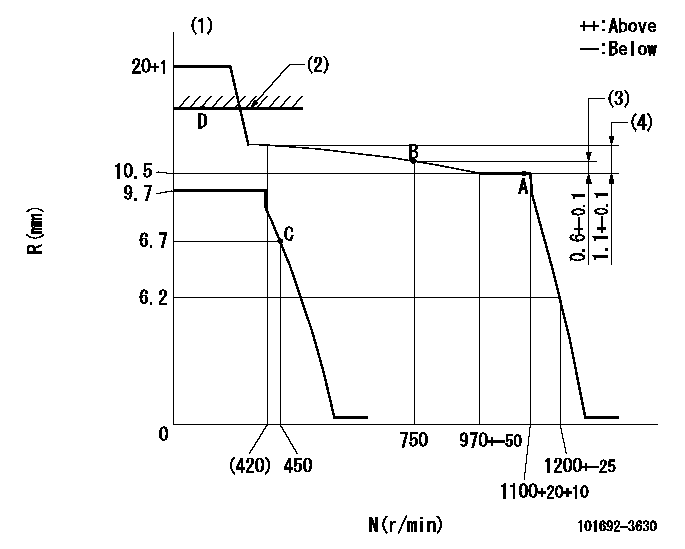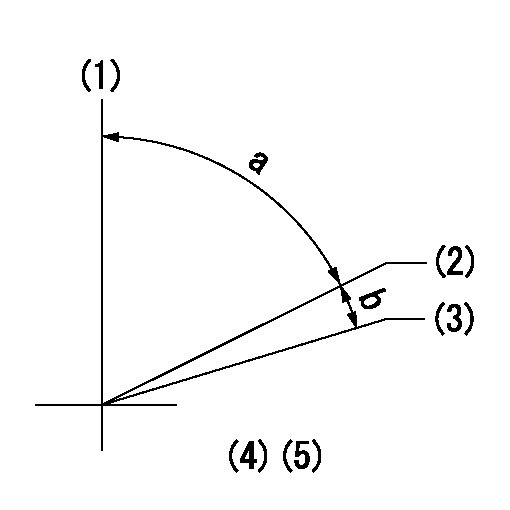Information injection-pump assembly
ZEXEL
101692-3630
1016923630
KOMATSU
6209711260
6209711260

Rating:
Cross reference number
ZEXEL
101692-3630
1016923630
KOMATSU
6209711260
6209711260
Zexel num
Bosch num
Firm num
Name
Calibration Data:
Adjustment conditions
Test oil
1404 Test oil ISO4113 or {SAEJ967d}
1404 Test oil ISO4113 or {SAEJ967d}
Test oil temperature
degC
40
40
45
Nozzle and nozzle holder
105780-8140
Bosch type code
EF8511/9A
Nozzle
105780-0000
Bosch type code
DN12SD12T
Nozzle holder
105780-2080
Bosch type code
EF8511/9
Opening pressure
MPa
17.2
Opening pressure
kgf/cm2
175
Injection pipe
Outer diameter - inner diameter - length (mm) mm 6-2-600
Outer diameter - inner diameter - length (mm) mm 6-2-600
Overflow valve
132424-0620
Overflow valve opening pressure
kPa
157
123
191
Overflow valve opening pressure
kgf/cm2
1.6
1.25
1.95
Tester oil delivery pressure
kPa
157
157
157
Tester oil delivery pressure
kgf/cm2
1.6
1.6
1.6
Direction of rotation (viewed from drive side)
Right R
Right R
Injection timing adjustment
Direction of rotation (viewed from drive side)
Right R
Right R
Injection order
1-5-3-6-
2-4
Pre-stroke
mm
3.2
3.15
3.25
Rack position
Point A R=A
Point A R=A
Beginning of injection position
Drive side NO.1
Drive side NO.1
Difference between angles 1
Cal 1-5 deg. 60 59.5 60.5
Cal 1-5 deg. 60 59.5 60.5
Difference between angles 2
Cal 1-3 deg. 120 119.5 120.5
Cal 1-3 deg. 120 119.5 120.5
Difference between angles 3
Cal 1-6 deg. 180 179.5 180.5
Cal 1-6 deg. 180 179.5 180.5
Difference between angles 4
Cyl.1-2 deg. 240 239.5 240.5
Cyl.1-2 deg. 240 239.5 240.5
Difference between angles 5
Cal 1-4 deg. 300 299.5 300.5
Cal 1-4 deg. 300 299.5 300.5
Injection quantity adjustment
Adjusting point
A
Rack position
10.5
Pump speed
r/min
1100
1100
1100
Average injection quantity
mm3/st.
73.7
72.7
74.7
Max. variation between cylinders
%
0
-2.5
2.5
Basic
*
Fixing the lever
P
Injection quantity adjustment_02
Adjusting point
-
Rack position
8.2+-0.5
Pump speed
r/min
450
450
450
Average injection quantity
mm3/st.
12.5
11.5
13.5
Max. variation between cylinders
%
0
-15
15
Fixing the rack
*
Remarks
Adjust only variation between cylinders; adjust governor according to governor specifications.
Adjust only variation between cylinders; adjust governor according to governor specifications.
Test data Ex:
Governor adjustment

N:Pump speed
R:Rack position (mm)
(1)Target notch: K
(2)RACK CAP: R1
(3)Rack difference between N = N1 and N = N2
(4)Rack difference between N = N3 and N = N4
----------
K=9 R1=(17.5)mm N1=1100r/min N2=750r/min N3=1100r/min N4=400r/min
----------
----------
K=9 R1=(17.5)mm N1=1100r/min N2=750r/min N3=1100r/min N4=400r/min
----------
Speed control lever angle

F:Full speed
I:Idle
S:Stop
----------
----------
a=13deg+-5deg b=32deg+-3deg c=35deg+-5deg
----------
----------
a=13deg+-5deg b=32deg+-3deg c=35deg+-5deg
Timing setting

(1)Pump vertical direction
(2)Position of key groove at No 1 cylinder's beginning of injection
(3)Stamp aligning marks on the pump housing flange.
(4)-
(5)-
----------
----------
a=58deg+-3deg b=2deg+-30min
----------
----------
a=58deg+-3deg b=2deg+-30min
Information:
Fuel System Information
Fill the fuel tank at the end of each day of operation to drive out moist air and to prevent condensation. Do not fill the tank to the top. Fuel expands as it gets warm and may overflow.
Do not fill fuel filters with fuel before installing them. Contaminated fuel will cause accelerated wear to fuel system parts.
Fuel Recommendations
Preferred Fuel Grades
The two types of preferred diesel fuel available for your truck engine are typically grades No.1 (winter) and No.2 (summer). Although No.2 diesel fuel is the most commonly used fuel, No.1 diesel fuel or a blend of No.1 and No.2, is the fuel that is best suited for cold weather operation.There are three major differences between No.1 and No.2 diesel fuel.* No.1 diesel fuel has a lower cloud point. The cloud point is the temperature at which a cloud or haze of wax crystals will begin to form in the fuel and cause fuel filters to plug.* No.1 diesel fuel has a lower pour point. The pour point is the temperature which diesel fuel will begin to thicken and be more resistant to flow through fuel pumps and lines.* No.1 diesel fuel has has a lower kJ (Btu) (heat content) rating per unit volume of fuel than the average No.2 diesel fuel. When using No.1 diesel fuel or modified summer blended fuel, you may notice a drop in power and fuel efficiency, but should not experience any other operating effects.Before troubleshooting for low power or poor performance in winter months, check the type of fuel or fuel blend being used. Be aware of these fuel values when purchasing your diesel fuel and anticipate the average outside (ambient) temperature for the area your engine will be operating. Engines fueled in one climate may not operate satisfactorily if moved to another because of problems that result from cold weather. Use only fuel as recommended in this section. The fuels recommended for use in Caterpillar engines are No.2-D diesel fuel and No.2 fuel oil (summer), although No.1 (winter) grades are acceptable. The following fuel specifications are worldwide fuels which also meet Caterpillar requirements. These fuel characteristics should be considered when procuring fuel for use in Caterpillar diesel truck engines. Caterpillar Diesel Engines are capable of burning a wide range of distillate fuels. The use of clean, stable blends of distillate fuel which meet the following requirements will provide quality engine service life. Permissible Alternate Fuels
Fuel Mixing for Arctic Operation
Refer to the Cold Weather Operation topic in this Manual or the Truck Owner Manual for additional information.During cold weather operation, it may be necessary for you to use No.2 diesel fuel since quantities of No.1 diesel fuel are limited and generally are only available during the winter months and in the colder climates. In this case, summer grade fuel may be blended with No.1 fuel or kerosene in the following proportions. In temperatures down to -54°C (-65°F), use of distillate fuels meeting the following specifications are permitted. These fuels are lighter
Fill the fuel tank at the end of each day of operation to drive out moist air and to prevent condensation. Do not fill the tank to the top. Fuel expands as it gets warm and may overflow.
Do not fill fuel filters with fuel before installing them. Contaminated fuel will cause accelerated wear to fuel system parts.
Fuel Recommendations
Preferred Fuel Grades
The two types of preferred diesel fuel available for your truck engine are typically grades No.1 (winter) and No.2 (summer). Although No.2 diesel fuel is the most commonly used fuel, No.1 diesel fuel or a blend of No.1 and No.2, is the fuel that is best suited for cold weather operation.There are three major differences between No.1 and No.2 diesel fuel.* No.1 diesel fuel has a lower cloud point. The cloud point is the temperature at which a cloud or haze of wax crystals will begin to form in the fuel and cause fuel filters to plug.* No.1 diesel fuel has a lower pour point. The pour point is the temperature which diesel fuel will begin to thicken and be more resistant to flow through fuel pumps and lines.* No.1 diesel fuel has has a lower kJ (Btu) (heat content) rating per unit volume of fuel than the average No.2 diesel fuel. When using No.1 diesel fuel or modified summer blended fuel, you may notice a drop in power and fuel efficiency, but should not experience any other operating effects.Before troubleshooting for low power or poor performance in winter months, check the type of fuel or fuel blend being used. Be aware of these fuel values when purchasing your diesel fuel and anticipate the average outside (ambient) temperature for the area your engine will be operating. Engines fueled in one climate may not operate satisfactorily if moved to another because of problems that result from cold weather. Use only fuel as recommended in this section. The fuels recommended for use in Caterpillar engines are No.2-D diesel fuel and No.2 fuel oil (summer), although No.1 (winter) grades are acceptable. The following fuel specifications are worldwide fuels which also meet Caterpillar requirements. These fuel characteristics should be considered when procuring fuel for use in Caterpillar diesel truck engines. Caterpillar Diesel Engines are capable of burning a wide range of distillate fuels. The use of clean, stable blends of distillate fuel which meet the following requirements will provide quality engine service life. Permissible Alternate Fuels
Fuel Mixing for Arctic Operation
Refer to the Cold Weather Operation topic in this Manual or the Truck Owner Manual for additional information.During cold weather operation, it may be necessary for you to use No.2 diesel fuel since quantities of No.1 diesel fuel are limited and generally are only available during the winter months and in the colder climates. In this case, summer grade fuel may be blended with No.1 fuel or kerosene in the following proportions. In temperatures down to -54°C (-65°F), use of distillate fuels meeting the following specifications are permitted. These fuels are lighter